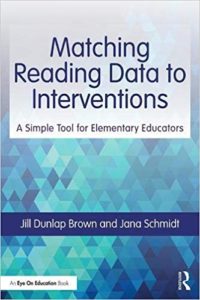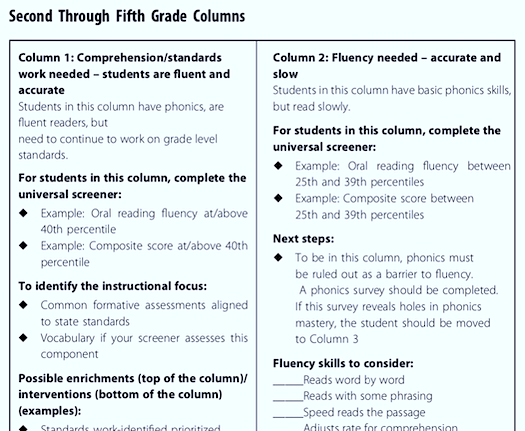Matching Reading Data to Interventions
Matching Reading Data to Interventions: A Simple Tool for Elementary Educators
By Jill Dunlap Brown and Jana Schmidt
(Routledge/Eye On Education, 2020 – Learn more)
Reviewed by Ginny Hornberger
![]() My last year teaching fourth grade, a student in my class, Thomas, despised reading. He was not identified as an English language learner nor did he qualify for Special Education, yet he struggled with each day’s in-class assignment.
My last year teaching fourth grade, a student in my class, Thomas, despised reading. He was not identified as an English language learner nor did he qualify for Special Education, yet he struggled with each day’s in-class assignment.
The reading specialists knew him well, for he’d spent the past three years in pull-out programs and intervention sessions.
As a classroom teacher, my solutions were limited. I would have him sit beside me reading the text or completing the assignment on his own while I worked with small groups of students. I tried various intervention resources to help improve his reading, but most of the time I was guessing on what would work best.
 I had data on Thomas. I did fluency checks, benchmark testing at the beginning and the middle of the year (the end-of-year benchmark test was not given due to the pandemic), and sight word testing. I had data from the reading specialists and our state assessment test in third grade.
I had data on Thomas. I did fluency checks, benchmark testing at the beginning and the middle of the year (the end-of-year benchmark test was not given due to the pandemic), and sight word testing. I had data from the reading specialists and our state assessment test in third grade.
Despite access to all of this data, very little progress was made and at the end of the year, Thomas was still reading more than two years below grade level. I had failed him as a reading teacher but not for lack of knowledge or a lack of trying.
This situation is not unique. Teachers want to help every child become a successful reader. Universities train teachers, school districts offer professional development, administrators provide programs, reading specialists supply assessment data, and teachers spend hours reviewing data, resources, and lesson plans. But many students still struggle to read proficiently.
What’s the Solution?
What more do teachers need to help students read? Columns, that’s what!
Teachers searching for a systematic approach to reading the data and applying it to interventions need look no further than Jill Dunlap Brown and Jana Schmidt’s perfectly titled book, Matching Reading Data to Interventions: A Simple Tool for Elementary Educators. Brown and Schmidt offer the quintessential tool for matching student data to the appropriate reading intervention with ‘The Columns’ strategy.
The authors created ‘The Columns’ to provide teachers a way to match student data to an appropriate reading intervention. Teachers in grades 4-5, take note!
What’s in the Book
Here’s the Table of Contents:
- An Overview of The Columns
- Kindergarten and The Columns
- Grade One and The Columns
- Column One for Grades 2-5
- Column Two for Grades 2-5
- Column Three for Grades 2-5
- Column Four for Grades 2-5
- Case Studies for each Grade Level
- A Guide to The Columns Implementation
Chapter One gives an overview of The Columns. The authors concisely describe the need for this systematic approach to intervention, give a brief explanation of each column, and address a few special considerations, such as why Kindergarten and First Grade each have a dedicated chapter in the book and how this book is helpful to administrators.
Each of the following six chapters focus on grades two through five. The chapters provide a step-by-step process of using multiple factors and reading tools to guide teachers to the correct foundational reading deficit at each column level, allowing the reader to distinguish between columns one through four.
Chapter 8, the créme de la créme of this book, provides case studies for each grade level from kindergarten through fifth grade. These scenarios provide sample student data and challenge teachers to decipher the data while placing students into the appropriate column. Once the teachers have moved through the exercise, the authors share their own column assignments for comparison.
The final chapter offers a guide to actually implementing The Columns in the school’s intervention program at the team, school, or district level.
Here Comes My Gush!
According to the National Assessment of Educational Progress (NAEP), the average reading score for 4th-grade students in 2019 was 220 on a 500 point scale. Evidently, every person working in an elementary school needs to focus on increasing children’s reading ability. This book will help align an entire educational system to do just that.
Teachers, this book will become your “go-to” for reading intervention. The easy-to-follow process, concise explanations, Column case studies, and resource suggestions provide a framework to clearly identify what each child needs and how to proceed for a successful outcome.
Administrators and educational leaders, get this book on your desk if you plan on implementing a Multi-Tier System of Supports (MTSS) in your school. No need to be a reading specialist or even a reading teacher to understand the Column’s process of matching the reading data to the correct intervention. The authors provide unbiased, useful suggestions about a variety of reading programs and resources – allowing districts to use resources they may already have in their schools.
The case studies alone make this a “must-have” book for any school enacting a reading intervention plan. The authors’ concise, to-the-point, and student-centered case studies make proficient student reading levels more achievable for teachers. The Columns remove the guesswork and make the data actionable.
The Columns offer the missing piece to the puzzle of providing students with the proper literacy intervention “on demand.” Matching Reading Data to Interventions makes all of the data collected by educators both relevant and meaningful. I have little doubt implementing strategies in this book will result in literary success for our students.
Virginia Hornberger became an assistant principal at Muhlenberg Elementary Center in 2020. She has spent the majority of her educational career in the Muhlenberg School District in various capacities. Her educational achievements include earning a Masters of Language and Literacy from Millersville University and Masters of Educational Technology from Wilkes University,. She also holds a reading specialist certification. She enjoys reading professional literature, non-fiction novels, and children’s literature. Her days spent with her three children – Elizabeth, JeanLouise, and Thomas – and her dog Frankie make her the happiest.



































Oh, my goodness! Ginny! I am one of the authors of this book, and your review just brought tears to my eyes! Thank you doesn’t seem nearly enough for your kind words. I am on a mission to ensure every child learns to read and every teacher is empowered to make sure this happens! If there is ever anything I can do to help you or your students, please don’t ever hesitate to reach out to me. THANK YOU for reading our book, for this amazing review, and thank you for the life-changing work I know you are doing with kids.
My best,
Jill Dunlap Brown